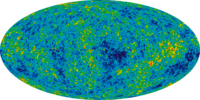
Photo from wikipedia
Author(s): Han, J; Ferraro, S; Giusarma, E; Ho, S | Abstract: © 2019 The Author(s). We study the cross-correlation between the Planck cosmic microwave background (CMB) lensing convergence map and… Click to show full abstract
Author(s): Han, J; Ferraro, S; Giusarma, E; Ho, S | Abstract: © 2019 The Author(s). We study the cross-correlation between the Planck cosmic microwave background (CMB) lensing convergence map and the extended-Baryon Oscillation Spectroscopic Survey (e-BOSS) quasar overdensity obtained from the Sloan Digital Sky Survey (SDSS) IV, in the redshift range 0.9 l z l 2.2. We detect the CMB lensing convergence–quasar cross-power spectrum at 5.4σ significance. The cross-power spectrum provides a quasar clustering bias measurement that is expected to be particularly robust against systematic effects. The redshift distribution of the quasar sample has a median redshift z ≈ 1.55, and an effective redshift about 1.51. The best-fitting bias of the quasar sample is b q = 2.43 ± 0.45, corresponding to a host halo mass of log 10 h − 1MM = 12.54 +−00 .. 2536 . This is broadly consistent with the previous literature on quasars with a similar redshift range and selection. Since our constraint on the bias comes from the cross-correlation between quasars and CMB lensing, we expect it to be robust to a wide range of possible systematic effects that may contaminate the autocorrelation of quasars. We checked for a number of systematic effects from both CMB lensing and quasar overdensity, and found that all systematics are consistent with null within 2σ. The data are not sensitive to a possible scale dependence of the bias at present, but we expect that as the number of quasars increases [in future surveys such as Dark Energy Spectroscopic Instrument (DESI)], it is likely that strong constraints on the scale dependence of the bias can be obtained.
Journal Title: Monthly Notices of the Royal Astronomical Society
Year Published: 2019
Link to full text (if available)
Share on Social Media: Sign Up to like & get
recommendations!